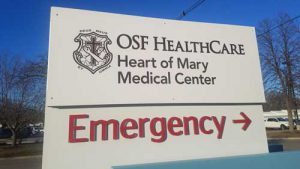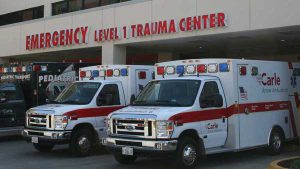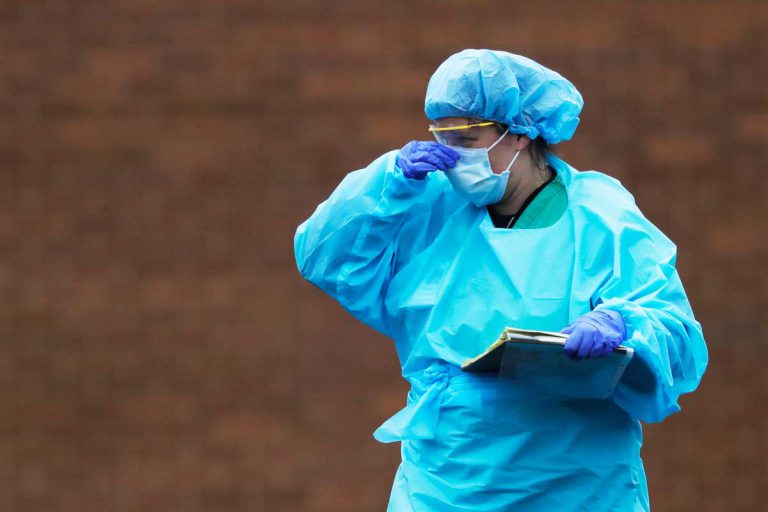URBANA – Across Illinois’ Region 6, which includes 21 counties in east-central Illinois, hospitals have less than 30% capacity remaining in their medical-surgical and intensive care units, local health officials reported this week.
Hospitals are filling up with COVID-19 patients as rates of community transmission rise throughout the region, says Champaign-Urbana Public Health Administrator Julie Pryde.
In some parts of the country, there are concerning reports of hospitals having to divert ambulances with sick patients because they are full.
“Obviously we do not want to see that in our community,” Pryde says.
Preventing that outcome will require putting the brakes on the spread of the virus, which Pryde says comes down to individual behaviors. In central Illinois, like many other areas, gatherings, including weddings and parties, are fueling the recent surge.
As the virus takes off in the region, area hospitals are exploring ways to reduce hospitalizations and increase capacity. And many are grappling with ethical questions, including: How will care be prioritized when all the beds are full?

‘If everybody’s at capacity, what do you do then?’
Leaders of central Illinois hospital systems — including OSF, Carle and Memorial — say that their hospitals are seeing record high numbers of COVID-19 patients and are getting close to capacity.
Dr. Jared Rogers, president of OSF HealthCare Heart of Mary Medical Center in Urbana, says in the past couple of weeks, there have been times the hospital ran out of space.
In those instances, when new patients arrive, Rogers says they have been able to arrange a transfer to other hospitals within OSF’s system or to Carle Foundation Hospital in Urbana.
The concern is that if the virus keeps spreading at the current rate, all hospitals in the region could get filled up.
“And if everybody’s at capacity, what do you do then?” Rogers says. “Then you have to start triaging and treating those that you can make the most difference in with the supplies, skills and facilities that you have. And nobody wants to get to that position.”
Like many hospitals, leaders at OSF and Carle are exploring ways to increase capacity in response to the growing need.
This is important not only to accommodate the increasing number of COVID-19 patients requiring hospitalization, but also to ensure hospitals can continue to respond to emergencies such as car accidents, heart attacks and strokes.
Increasing hospital capacity requires more than just adding more beds, ventilators and other equipment. Hospital leaders say the limiting factor often comes down to staffing: Do they have enough people trained to provide specialized care?
Dr. David Chan, Carle Foundation Hospital’s associate chief medical officer, says the hospital has created an extra unit to provide eight more ICU beds.
But when it comes to staffing, they are walking a fine line of asking employees to work extra shifts and ensuring people have time to rest.
“We can’t ask them to work 24/7,” Chan says, “which is when we get into a dangerous situation where the best of anyone will start having less than 100% efficiency and effectiveness in caring for these very sick patients.”
The other problem: as rates of viral transmission increase in communities across the region, more health care workers are contracting the coronavirus themselves and are needing to isolate, creating additional staffing constraints.

Chan says Carle’s chief nursing officer has been successful at bringing in additional nurses — including reassigning people and calling back nurses who had moved on to other non-clinical roles.
Strained hospitals are grappling with ethical questions
Since Carle and OSF both accept patients from across a large swath of central Illinois, they are feeling the strain — as they strive to provide a safety net for the region during a time when cases are spiking.
Patients have been arriving at Carle from areas that extend beyond their traditional bounds, Chan says, because hospitals in others areas aren’t equipped to provide the higher levels of care some patients need.
“And because we do feel an obligation to be the safety net, we will accept them if we do have the resources,” Chan says.
He says his team at Carle is having ongoing discussions that include ethical questions regarding how they will prioritize care as resources get stretched thin.
“The challenge will be: When we are short of resources or potentially out of resources, how do we deal with that at that time?” Chan says.
It’s not unusual for Carle to get a call from a hospital that is hours away, saying, they’ve called more than a dozen hospitals searching for a placement for the patient, he adds.
“These hospitals… are doing anything they can to be able to get a patient placed who is intubated, who is obviously ICU-bound but [they] do not have the capacity to do that,” Chan says.
This is the reason he’s joining the chorus of health care and public health experts calling on every person to help stop the spread.
“We can’t do this alone,” he says. “We really need the community to rally to help us to dampen this onslaught of surge patients.”
Carle and Memorial have released public dashboards, updated daily with information on COVID-19 deaths and hospitalizations across each of their five-hospital systems — aimed helping the public understand the urgency of the situation.
Rogers says OSF provides daily updates to local health departments and is considering also launching a public database in the future.
Care is improving — but prevention is the best medicine
Hospitals are getting better at treating patients with COVID-19, Rogers says.
This includes things like not rushing to put someone onto a ventilator and positioning patients on their abdomen to help ventilate the lungs better — strategies that have “been shown to be advantageous in most cases,” Rogers says.
Health care providers also know more about medications that can help patients avoid blood clots caused by the virus and other drugs that can lead to a quicker recovery for certain patients, he adds. People in certain high-risk groups may also qualify for a new antibody treatment that has received emergency use authorization from the FDA for the treatment of mild to moderate COVID-19.
But prevention, as always, is the best strategy for combatting the pandemic, Rogers says.
And once a coronavirus vaccine becomes available, he hopes people will strongly consider getting it.
Three vaccines currently in development — from Pfizer, Moderna and AstraZeneca — have shown promising results in clinical trials.
Chan says he is “hoping and praying” the long-awaited coronavirus vaccines will be made available soon and have an impact on the pandemic. Carle has already begun purchasing the freezers they will need to store the vaccine, he says.
Pryde says C-U Public Health is gearing up to facilitate vaccine distribution, which could begin as early as mid-December, with priority given to health care staff and others who work in health care facilities.
Pryde says east-central Illinois is going to see “a lot of tragedy” in the upcoming months.
To minimize the number of people dying from the virus — and to prevent hospitals from getting overwhelmed — she joins state health officials in urging everyone to stay home as much as possible.
“Keep your Thanksgiving celebrations to those in your household, and… make sure you continue masking, distancing and practicing good hand hygiene,” she says.
“We will be needing to remain extra vigilant through this winter.”
Christine Herman is a reporter with Illinois Newsroom. Follow her on Twitter: @CTHerman

